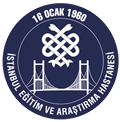ABSTRACT
Introduction:
Trapezius myalgia (TM) is the chronic pain of trapezius muscle, one of the most common reasons for shoulder pain seen in a common population. The aim of our study is to determine the effects of an existence of preoperative TM to the postoperative pain in the patients, who underwent a laparoscopic cholecystectomy.
Methods:
After receiving an ethical committee approval, we have included 60 ASA 1-2 patients who underwent a laparoscopic cholecystectomy surgery in the general surgery operating room in University of Health Sciences Turkey, İstanbul Training and Research Hospital between January and June 2015. The patients who were classified as ASA 3-4, had head and neck surgery or trauma, operations which had started as the laparoscopic procedures but then had to be performed as an open surgery, patients who had rheumatological and neurological diseases, tendinitis that affects the shoulder joints, and patients who had to have the emergency surgeries were excluded in this study. Patients were divided into two groups, one with (TM+) and who were not having (TM), when evaluated preoperatively. Each group had analgesia by a patient-controlled device. Using Numeral Rating scale demographical data, shoulder and umbilical pain levels were evaluated, and postoperative analgesic needs and doses were recorded in the case files.
Results:
Five patients who were excluded; n=26 in TM+ group and n=29 in TM group were taken. There was no significant demographic difference found between two groups. No statistically significant difference was found between TM+ and TM- groups (p>0.05). While no statistically significant difference was established in the tramadol doses between two groups, a total of ten patients out of 26 TM+ had shoulder pain, and additional analgesic need was found statistically increased in TM+ group (p<0.001).
Conclusion:
We have concluded that the existence of a preoperative TM increased the need for analgesics postoperatively, this could be important for choosing the analgesic regimen, and that the TM should be considered after a laparoscopic cholecystectomy.
Introduction
Postoperative pain is a kind of acute pain which appears to happen due to a surgical trauma, and which decreases eventually by healing of tissues. The postoperative pain severity differs from patients to patient, and it is very subjective (1,2). The curing of pain is a very important process for the patient. Although postoperative pain appears to happen less in a laparoscopic cholecystectomy in comparison to the conventional methods, it is not a pain free method either.
The pain that occurs after a laparoscopic cholecystectomy clinically consists of three components. Visceral pain (deep abdominal pain), somatic pain (incisional pain), and shoulder pain (reflexion of a visceral pain). Shoulder pain appears because of a CO2 insufflation, depending on the diaphragmatic and phrenic nerve irritation. Shoulder pain may increase with the movements and may continue for a few days after the operation, also the insufflated gas may cause severe pain (3). The severity of the postoperative pain cannot be predicted in length, and it shows individual differences (4).
The main reason why our patients come to our hospitals, who are the majority of the population consisting of women and lower income group, is that; they suffer from a chronic pain based on the chronic muscle-skeleton system (3,5).
Trapezius myalgia (TM) is one of those pains which is basically a chronic pain of the trapezius muscle, it is not only having the multifactorial ethnology, but also forms the 10-20% of the persistent pains (6-9).
In fibromyalgia, myofascial pain syndrome and the TM (which occurs as the component of both) patients detect some stimulators as a pain, although these are just stimulators caused by the change in the processing the pain and senses. This situation may cause an increase in the using analgesic caused by a decreased sensitivity to peripheral and central sensitization (10-13). In our study, we considered this situation and planned to work on the effects of the existence of a chronic TM pain on a postoperative pain in laparoscopic cholecystectomy patients.
Methods
After we got the University of Health Sciences Turkey, İstanbul Training and Research Hospital Ethics committee (approval number: 677, date: 03.07.2015), a total of 60 voluntary patients are chosen randomly between the dates January and June 2015, who were going to have the ASA 1-2 laparoscopic cholecystectomy operation in the University of Health Sciences Turkey, İstanbul Training and Research Hospital general surgery operating room. Their consent was taken before starting the study. Some of the patients who have ASA 3-4, neck or shoulder operation, or trauma, rheumatic diseases, and who had to have an emergency operation are excluded from the study. Patients’ age, gender, height, weight, body mass index (BMI), American Society of Anesthesiologists (ASA) scores are recorded on case report forms. In preoperative period, the existence of a TM is confirmed by pressing the thumb to the middle of the trapezius muscle on both the sides with approximately 4 kg of pressure (enough to make the nails white), and the patients’ sensitivity toward this examination was observed. Patients are separated into the two groups, as the ones with the TM and the ones without it. General routines on anesthesia conditions are provided, and they are operated. During the operation, general anesthesia induction is given 2 mg/kg fentanyl + 2 mg/kg propofol + 0.5 mg/kg rocuronium, and during the maintenance 50% oxygen with 50% air mixture and 2% sevoflurane is used. To the patients in both the groups 300 mg tramadol HCL/100 cc mediflex, 10 mg/h basal infusion, 10 mg bolus dose is given with the controlled analgesia device (CADD-Legacy Patient Control Analgesia device Model 6300 Ambulatory Infusion Pump Smith Medical ASD, Inc. St. PAUL mn 55112 USA) with a 15 minutes lock down period.
In a postoperative period, patients who need analgesics are given with 1 mg paracetamol intravenous. Patients are visited in the 1st, 2nd, 4th, 8th, 12th, 18th hours, and checked if they had any pain in the shoulder or in the umbilical part of their body, scaled by the Numerical Rating scale (NRS); 0=no pain, 10=severe pain) and recorded. Patients’ tramadol dosage, additional analgesic need, and the dose if needed are also recorded.
Statistical Analysis
Statistical analyses are done by using the SPSS version 15 software. The suitability of the variables to a normal criteria are inspected by the visuals (histogram and probability charts) and analytical methods (Kolmogorov-Smirnov/Shapiro-Wilk tests), descriptive analysis for abnormal variables are given using the mid and interquartile intervals. Postoperative NRS scores are compared using a Mann-Whitney U test, because NRS scores in 1st, 2nd, 4th, 8th, 12th, and 18th hours do not show normal dispersion. The cases where p-value is <0.05 are considered statistically significant.
Results
In our study, a total of 60 patients are included. In that, 30 of them with TM and 30 of them without it. Five of the patients are later excluded from the study, because their operation started as laparoscopy but then changed to open cholecystectomy. Patients’ demographic data and ASA scores are shown in the Table 1.
Despite that; after the statistical analysis done, statistically significant difference is not observed between TM+ and TM groups in terms of umbilical NRS scores (Table 2).
In conclusion to the statistical comparisons, no difference is found between TM+ and TM groups in accordance with age, BMI, and ASA rates. In conclusion to a statistical analysis, additional analgesics is found to be needed for ten patients out of 26 (38.4%) in TM+ group and five patients out of 29 (17.2%) in TM group. This situation is found statistically and meaningfully high (p=0.001) (Table 3). Paracetamol 1 gram intravenous is given to the ones who needed it. When the groups are compared about the tramadol dosages, no significant difference was detected (Table 4). According to the statistical analysis done, ten patients out of 26 in TM+ group had a shoulder pain.
Discussion
In our study while there was no difference found between the TM+ and TM groups according to the tramadol dosage, ten patients out of 26 with TM had a shoulder pain, and we observed that the TM+ group needed the additional analgesics. Despite that, in terms of umbilical NRS scores, there is no statistically important difference found between the groups. In the study of Kim et al. (14) conducted in 64 patients, the postoperative pain score is noted to be the highest in the 24th hour, and patients were observed for 48 hours. But in our study we were able to observe our patients only for 18 hours, because they were given with the oral analgesics and discharged earlier.
According to a study by Avtan et al. (15) having the sample size of 72 patients in purpose of searching the pain mechanism, the reasons of the pain and curing methods after a laparoscopic cholecystectomy is observed. They detected a postoperative pain in 63 of the patients. In 43 patients, the pain is detected mostly in trocar, in 21 patients the pain is detected in the right hypochondrium and back, and in 8 patients in shoulder (15).
In another study by Joris et al. (16) on 20 patients, they compared incisional, visceral, and shoulder pain. They realized that in postoperative 48 hours, incisional and visceral pain is felt much more intensely than a shoulder pain (16). After the laparoscopic cholecystectomy operations, it is seen that the left shoulder is also affected as well as the right shoulder (16).
Another study done by Lee et al. (17) about a post laparoscopic shoulder pain incidence, they reported that after 24 hours, 33 patients (39.3) said that wound pain is more severe than the shoulder pain, 41 patients (48.8) said wound pain is less than the shoulder pain, and 10 patients (11.9) said wound pain and shoulder pain are equal. The different results between those studies and our study may be related to the existence of TM or because of the difference between our perioperative analgesic usage protocols.
In our study we thought the reason why the shoulder pain is not detected in the TM cases are because the pain was dominated by the visceral pain. While the TM patients’ shoulder pain may be caused by the TM, it may also be because of the effects of this illness which causes some changes in the procession of senses and central sensitization (18).
In our study, there were no differences found between the groups in terms of tramadol usage doses, but the need of additional analgesics was higher in the TM+ group than the TM group. As the reason of this situation, we thought that chronic existence of the TM’s effects on a peripheral and central sensitization, and reduced sensitivity to opioidergic effect.
Study Limitations
Because the laparoscopic cholecystectomy patients who agreed to be included in our study were all women, our study cannot be regarded as homogeneous in the aspect of gender. One of the other limitations was; while studies on this matter require 24-48 hours of acute pain follow-ups according to the literature, we were able to observe our patients just for 18 hours. This was because they were discharged prematurely due to the usage of the oral analgesics.
Conclusion
As a result, postoperative pain is unique. It may differ in the severity and it is subjective. Pain control is crucial in terms of an early discharge after operation, shortening the healing time, and reducing operational costs.
The patients who have chronic pain may sense pain because of the changes in their pain and sense process, whereas the normal people do not feel any pain at all. Peripheral sensitization, central sensitization, and reduced sensitivity to the opioidergic effect in neck neurons may cause an increase in the analgesics consumption.
In our study we took those data into consideration, and we think that the preoperative existence of TM increases the analgesic need during the postoperative period. Therefore, we came into a conclusion that, the patients who have shoulder pain after a laparoscopic cholecystectomy in postoperative period, TM should be taken into consideration and the existence of the TM is very important in the analgesics regimen planning.



